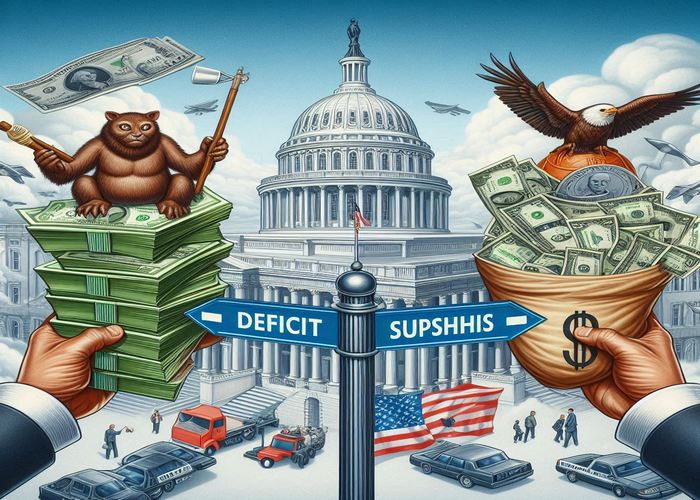The ebb and flow of the US federal budget, oscillating between deficit and surplus, can have significant implications for the economy. Whether the government is spending more than it collects in revenue, or the reverse, these budgetary dynamics play a crucial role in shaping the nation's financial landscape. As an informed citizen or economic analyst, understanding the nuances of the federal budget is essential to navigating the complexities of the economic landscape.

Understanding the Dynamics of the US Federal Budget Deficit
A federal budget deficit occurs when the government's expenditures exceed its revenues. This imbalance can arise from a variety of factors, including increased spending on social programs, infrastructure projects, or military operations, coupled with stagnant or declining tax revenues. The causes of a budget deficit can be complex, often rooted in economic conditions, political priorities, and policy decisions.
The consequences of a budget deficit can be far-reaching, potentially leading to increased government borrowing, higher interest rates, and a growing national debt. Policymakers must carefully consider the trade-offs and devise strategies to address the deficit while maintaining economic stability.
Factors Driving the Shift from Budget Deficit to Surplus
Conversely, the US federal government may experience a budget surplus, a scenario where revenues exceed expenditures. This shift can be driven by a range of factors, such as strong economic growth, higher tax revenues, or concerted efforts to rein in government spending.
When the federal budget is in surplus, the government may choose to use these additional funds to pay down the national debt, invest in infrastructure, or even provide tax cuts to stimulate the economy. The presence of a budget surplus can signal financial stability and open up new opportunities for policymakers to shape the economic landscape.
Implications of a Budget Surplus for the US Economy
A federal budget surplus can have both positive and negative implications for the US economy. On the positive side, a surplus can enable the government to reduce the national debt, freeing up resources for other priorities. Additionally, a surplus can inject liquidity into the financial system, potentially leading to lower interest rates and increased investment.
However, a budget surplus also carries risks, such as the potential for overheating the economy or limiting the government's ability to respond to economic downturns. Policymakers must carefully balance the benefits of a surplus with the potential drawbacks to ensure a stable and prosperous economic environment.The Cyclical Nature of Budget Balances: From Deficit to Surplus and Back
The US federal budget has historically exhibited a cyclical pattern, fluctuating between periods of deficit and surplus. These cycles are often driven by a complex interplay of economic conditions, political factors, and policy decisions.
For example, the US experienced significant budget deficits in the wake of the 2008 financial crisis, as the government implemented stimulus measures and faced declining tax revenues. In the ensuing years, the budget gradually shifted towards a surplus as the economy recovered and expenditures were brought under control.
Understanding the cyclical nature of budget balances is crucial for policymakers and economic analysts alike, as it allows them to anticipate and prepare for potential shifts in the fiscal landscape.
Key Events Shaping the US Federal Budget Trajectory
The trajectory of the US federal budget has been shaped by a series of key events and policy decisions over time. From major legislative changes, such as tax reforms and spending initiatives, to global economic shocks and geopolitical tensions, these events have had a profound impact on the government's fiscal position.
By examining the historical context and the driving forces behind budget dynamics, analysts can gain valuable insights into the potential future direction of the federal budget and its implications for the broader economy.
Interpreting Budget Dynamics: Pitfalls and Practical Applications
Navigating the complexities of the US federal budget requires a nuanced understanding of the underlying drivers and potential pitfalls. Policymakers, investors, and the general public must be vigilant in their interpretation of budget data, recognizing the limitations and potential biases inherent in the information.
By applying a comprehensive approach that considers economic indicators, political factors, and historical precedents, stakeholders can make more informed decisions and develop effective strategies to adapt to changing budget conditions.
Preparing for the Unexpected: Strategies for Navigating Budget Shifts
Given the dynamic and often unpredictable nature of the US federal budget, it is crucial for individuals, businesses, and policymakers to develop strategies for navigating unexpected shifts in budget balances.
This may involve diversifying investment portfolios, maintaining fiscal discipline, and implementing contingency plans to mitigate the impact of budget changes on personal or organizational finances. By anticipating and preparing for potential budget swings, stakeholders can better position themselves to weather economic storms and capitalize on emerging opportunities.
Conclusion
The US federal budget, with its ebb and flow between deficit and surplus, is a complex and ever-evolving landscape that holds significant implications for the economy. By understanding the drivers, implications, and cyclical nature of budget dynamics, policymakers, investors, and citizens can make more informed decisions and develop effective strategies to navigate the shifting fiscal landscape.
Whether faced with a budget deficit or surplus, the ability to interpret and respond to these budgetary shifts will be a critical determinant of success in the years to come. By embracing a comprehensive approach to analyzing and anticipating budget dynamics, stakeholders can position themselves for greater resilience and prosperity in an ever-changing economic environment.


